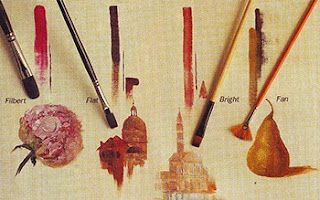Advertisement
What you need to know about Watercolor Brushes
If you're a watercolor painter, you have two basic categories of brush to consider when selecting the right tool to suit your painting needs. First, you'll need a brush that will deliver enough water and pigment to cover broad areas or washes. The flat, the wash and the mop are all good examples of this type of brush.
Secondly, you'll need another type of brush for drawing, details and special effects. The round is the most versatile brush in this category, but there are several other specialized brushes you can also check out. To get the best results for your own painting style, you'll want to experiment with several styles of brush in each category.
When shopping for brushes, be sure to evaluate their quality, Many brushes look good in the counter display, but appearances can be deceiving. A truly good watercolor brush doesn't just look good, it must also have snap, retain its shape when wet and have proper loading qualities. Most brushes come from the manufacturer with a coat of glycerine (sizing) on the hair. They look perfect with a fine point and a fat belly, but you won't know the true character of the brush until you've softened the glycerine coating. Especially when you're buying a round brush, ask for a glass of water to swish the brush in. Then try snapping it-literally snapping your wrist to reform the bristles. If the bristles don't return to a point or if there's more than one point, select another brush. This brush will probably never give you the results you want.
If you're a watercolor painter, you have two basic categories of brush to consider when selecting the right tool to suit your painting needs. First, you'll need a brush that will deliver enough water and pigment to cover broad areas or washes. The flat, the wash and the mop are all good examples of this type of brush.
Secondly, you'll need another type of brush for drawing, details and special effects. The round is the most versatile brush in this category, but there are several other specialized brushes you can also check out. To get the best results for your own painting style, you'll want to experiment with several styles of brush in each category.
When shopping for brushes, be sure to evaluate their quality, Many brushes look good in the counter display, but appearances can be deceiving. A truly good watercolor brush doesn't just look good, it must also have snap, retain its shape when wet and have proper loading qualities. Most brushes come from the manufacturer with a coat of glycerine (sizing) on the hair. They look perfect with a fine point and a fat belly, but you won't know the true character of the brush until you've softened the glycerine coating. Especially when you're buying a round brush, ask for a glass of water to swish the brush in. Then try snapping it-literally snapping your wrist to reform the bristles. If the bristles don't return to a point or if there's more than one point, select another brush. This brush will probably never give you the results you want.
 Looking at Hair
Looking at HairIn the world of watercolor brushes, kolinsky sable is considered the best you can get. In general, kolinsky provides excellent flow, spring and snap as well as a fabulous point. Unfortunately, a kolinsky sable can also be quite expensive, running as much as several hundred dollars for a large brush.
There are, however several other good options to choose from. Sable or red sable brushes are moderately priced and still quite responsive.



